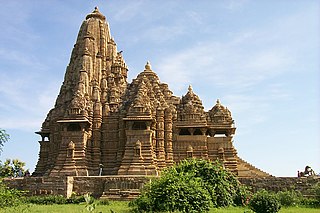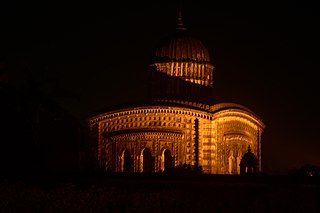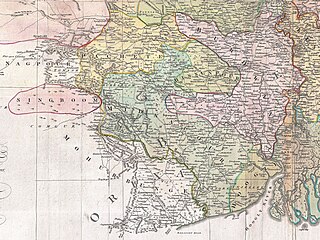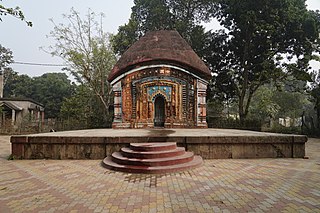
Indian architecture is rooted in the history, culture, and religion of India. Among several architectural styles and traditions, the best-known include the many varieties of Hindu temple architecture and Indo-Islamic architecture, especially Rajput architecture, Mughal architecture, South Indian architecture, and Indo-Saracenic architecture. Early Indian architecture was made from wood, which did not survive due to rotting and instability in the structures. Instead, the earliest existing architecture are made with Indian rock-cut architecture, including many Buddhist, Hindu, and Jain temples.

Hindu temple architecture as the main form of Hindu architecture has many varieties of style, though the basic nature of the Hindu temple remains the same, with the essential feature an inner sanctum, the garbha griha or womb-chamber, where the primary Murti or the image of a deity is housed in a simple bare cell. For rituals and prayers, this chamber frequently has an open space that can be moved in a clockwise direction. There are frequently additional buildings and structures in the vicinity of this chamber, with the largest ones covering several acres. On the exterior, the garbhagriha is crowned by a tower-like shikhara, also called the vimana in the south. The shrine building often includes an circumambulatory passage for parikrama, a mandapa congregation hall, and sometimes an antarala antechamber and porch between garbhagriha and mandapa. In addition to other small temples in the compound, there may be additional mandapas or buildings that are either connected or separate from the larger temples.

Bishnupur is a city and a municipality and now it is District in the state of West Bengal, India. It is known for its terracotta temples built by the Malla rulers, historic Radha Krishna temples built during 1600–1800 CE and the Baluchari sarees.

The Architecture of Bengal, which comprises the modern country of Bangladesh and the Indian states of West Bengal, Tripura and Assam's Barak Valley, has a long and rich history, blending indigenous elements from the Indian subcontinent, with influences from different parts of the world. Bengali architecture includes ancient urban architecture, religious architecture, rural vernacular architecture, colonial townhouses and country houses and modern urban styles. The bungalow style is a notable architectural export of Bengal. The corner towers of Bengali religious buildings were replicated in medieval Southeast Asia. Bengali curved roofs, suitable for the very heavy rains, were adopted into a distinct local style of Indo-Islamic architecture, and used decoratively elsewhere in north India in Mughal architecture.

Chandrakona is a town and a municipality in the Ghatal subdivision of Paschim Medinipur district in the state of West Bengal, India. The city is located between Ghatal and Garhbeta. The king – Chandraketu was the founder of the kingdom of Chandrakona. In Ain-E-Akbari it was mentioned as ‘Mana’.

Mallabhum was the kingdom ruled by the Malla kings of Bishnupur, primarily in the present Bankura district in Indian state of West Bengal.

There are eleven different types of buildings at the UNESCO-protected Champaner-Pavagadh Archaeological Park in Gujarat, India, including mosques, temples, granaries, tombs, wells, walls, and terraces. The monuments are situated at the foot of and around the Pavagadh Hill. The Baroda Heritage Trust lists 114 monuments in the area, of which only 39 are maintained by the Archaeological Survey of India, due to limited funding. The Forest Department owns 94% of the land here, while the temple trusts and other sectarian establishments provide facilities for boarding and lodging to pilgrims and tourists. On the southern side near the foot of the hill some dilapidated houses and the foundations of Jain temples can also be seen.
Manwal is a town in Udhampur district of the Jammu division of Jammu and Kashmir, India. It lies 28 km (17 mi) away from the district headquarters of Udhampur.

Kodandarama Temple is a Hindu temple dedicated to the god Rama, located in Vontimitta town in Vontimitta Mandalam of Kadapa District in the Indian state of Andhra. The temple, an example of Vijayanagara architectural style, is dated to the 16th century. It is stated to be the largest temple in the region. It is located at a distance of 25 kilometres (16 mi) from Kadapa and is close to Rajampet. The temple and its adjoining buildings are one of the centrally protected monuments of national importance.

Raghunath Malla Dev, also known as Raghunath Singha Dev, was the fifty-first king of the Mallabhum. He ruled from 1626 to 1656 CE.

Mudhai Devi temple is a temple of goddess Mudhai built as a Hemadpanti structure in village Waghali, in Chalisgaon tehsil of Jalgaon district in Khandesh region of Maharashtra, India.

Gokulchand Temple is a 17th-century stone built pancharatna temple in Gokulnagar village in the Joypur CD block in the Bishnupur subdivision of the Bankura district in the state of West Bengal, India.

Chandrakona Jorbangla Temple is a 17th-century stone built temple at Dakshinbazar, Chandrakona in Ghatal subdivision of Paschim Medinipur district in West Bengal, India.

Bengal temple architecture is about temple styles developed and used in Bengal, particularly the chala, ratna and dalan temples.

Radh Bengal is a region in West Bengal also known as the Temple Town. This region consists of arrays of temples in varying sizes and devoted to different gods and goddess but the common thread unifying this group is that the temples are constructed in terracotta. The region consists of following districts Birbhum, Bankura, Burdwan, Purulia and parts of Murshidabad. The construction style originated in 16th century and lasted till the 19th century. This period is also referred as a golden age of temple in West Bengal. Reason for development of this construction technique was the rich red laterite soil of the region and lack of construction worthy stone. The skill of creating daily objects from like vessels, pottery, seal and toys evolved into a construction technique in the time of need. These temples are baked terracotta panels or bricks. This particular style spread outside the present day West Bengal as well, to Jharkhand, Bihar, Assam and Tripura.

Ratna Style is a style of Bengal temple architecture, that originated in Bengal from the 15th to 16th centuries, under the Mallabhum kingdom. Originating as a regional style in Hindu temple architecture. It is an extended style of the Chala temple. The special feature of Ratna-style temples is the curved cornice of the chala.

Chala Style is a style of Bengal temple architecture, that originated in Bengal from the 15th centuries. Originating as a regional style in Hindu temple architecture. The main features of this style are curved tops and cornices. Chala-style temples in West Bengal were made of mud walls and thatched roofs. But, in East Bengal it was built with bamboo structures and thatched roofs.

Gopinath Temple, also known as Jor-Bangla Temple, is a Krishna temple at Pabna city of Rajshahi Division. In the past, the Hindu god Krishna was worshiped as Gopinath in this temple, but currently no worship is done. It is believed that the temple was built by Brajmohan Krori who was the tahsildar of Murshidabad Nawab. The temple is a great example of Jor-Bangla temple architecture belongs to Chala style, which was built in the 6th decade of the 19th century.

Madan Mohan Temple or Madanamōhana mandir is a Krishna temple in Bishnupur town of Medinipur division. In the past, the Hindu deity Krishna was worshiped in the form of Madanamohan in this temple, but currently no worship is conducted. According to the foundation plaque found in the temple, the temple was founded in 1694 AD by King Durjan Singha Dev of Mallabhum. The temple is a unique example of ekaratna temple architecture, which belongs to the Ratna style developed in medieval Bengal.




















